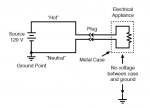Exactly what type of device is this and for what country and voltage? It is similar to a steam well. I am taking note there appear to be 2 elements that are protected by the apparent neutral [White Hi Temp line] headed to the other end along with what appears to be an extra black wire paried with it?/? Do you have a wiring diagram. Its puzzling. Its a little hard to see the phase separation with respect to the load by the photo.
The lower control almost looks like a mechanical timer, but could be a T-stat. The upper control almost looks like an infinite switch, and with this type of device you are correct. Its quite common to see a wire burned off and loose in the cabinet. I have seen it scores of times, and in those cases the ground appears to have been critical.

